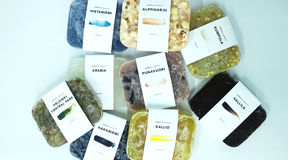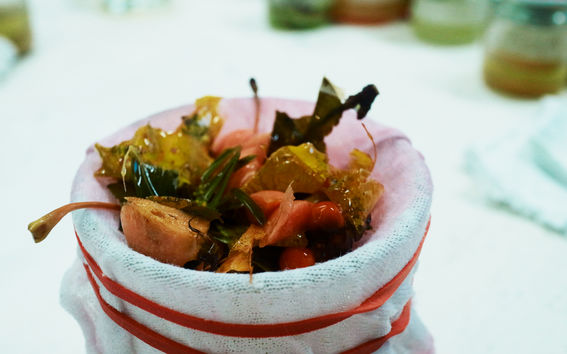Smellscapes of Helsinki: Local and Global Interactions

Background research:
The Dialectic of the Global and the Local
Cultural diversity seems to be endangered. The goods, services and cultural products that we consume tend to be similar in different parts of the world as an increasing amount of what we drink, eat, wear, see, read and come to want is currently provided by global corporations competing to expand the market for their goods and services (Crothers, 2012). In his book, Globalization and American Popular Culture, Lane Crothers mentions how ‘most of the globally ubiquitous commodities have their roots in America; they are the products of the first mass consumer society. Brand names like Coca-Cola, McDonald' s and Nike represent high-profile symbols which are (over) loaded with a series of complex cultural associations, and their continually growing global presence and appeal serve as evidence of the persisting presence, power and success of American commercial imperialism’ (Crothers, 2012). Therefore, the local, ‘authentic’ and ‘unique’ cultural expressions from places have the danger of being slowly homogenized and ignored.
However, considering globalization as a thread by polarizing it against the idea of local is also dangerous. After the 11th of September events in the United States, different countries around the world declared the war against terrorism and started to close their borders, looking inside and being aware of the other. In November 2001, UNESCO adopted a Universal Declaration on Cultural Diversity, looking for dialogue between cultures rather than segregation stating: “the protection of cultural diversity is an ethical imperative, inseparable from respect for human dignity. It implies a commitment to human rights and fundamental freedoms, and requires the full implementation of cultural rights, including the right to take part in cultural life” 3. This way, thinking about cultural diversity implies not only looking inside but also needs to be connected with the rest of the world.
Local wisdom is not isolated, as it is the knowledge and experience of those who discover things by living and working in one place (Fletcher, 2012), it is also the interactions between places. A simple example of this is Finland, which is very well known for its strong coffee culture, but this product is grown and imported mostly from Brazil and Colombia which also have different cultural expressions related to its production and consumption. Globalization is a non-linear, dialectic process in which the global and the local do not exist as cultural polarities but as combined and mutually implicating principles. The global and local are not separate containers but mutually constitutive social processes (Savage et al., 2004).
Becoming Local, Awareness and Smell
The idea of local is directly linked with the concept of place. Certain spaces become places when human agencies interact with them as the particularities of culture and history come to be inscribed in them (Casey, 1996). For example, a room, a house, a neighbourhood, a park or a city are not only physical spaces but also containers of emotions, memories, ideologies, traditions, knowledge and many other human intangible expressions. Spaces get meaning and then become places. Localism is also related with the identity of place, Michael Savage (2004) cites in his book, Globalization and Belonging, the anthropologist Arjun Appadurai, who argues that ‘localities are not given primordially but are socially produced through processes of boundary definition. Neighbourhoods are inherently what they are because they are opposed to something else and derive from other, already produced neighbourhoods (Savage et al., 2004). This means that places get their identity by the otherness and the differentiation between the experiences from one place to another, which of course are related to both subjective and objective interpretations.
The identity of place is given by how people experience it involving all the senses. Apart from what you see, what you can touch, smell, hear and sometimes taste, brings the particular characteristics of locations and their ‘uniqueness’, which sometimes people are not aware of. This experience involves both intimate and common feelings, as individual memories are woven together creating the fabric of the identity of places.
Smells are powerful triggers for emotions and certain aromas can even act as part of the common memory generation. This particular relationship between aromas and memories let us engage with our history in a more emotional way (Bembibre & Strlič, 2017). Cecilia Bembibre and Matija Strlič, from University College London Institute for Sustainable Heritage, wrote a research article related to smells and culture affirming that ‘in heritage guidelines, odors are often recognized as a value associated with a place, or with certain practices. Currently, smells are viewed as an aspect of cultural significance, an overall measure of the value of a particular place to the public’ (Bembibre & Strlič, 2017). This connection between odors and place has the opportunity of identifying them and also brings a particular experience different from other senses. Thus, this relationship encapsulates the importance of understanding the role of odors in the public’s memory or collective imagination as according to Bembibre and Strlič (2017) ‘communal value is also an assessment category that can be used to consider the cultural value of a smell. It derives ‘from the meanings of a place for the people who relate to it, or for whom it figures in their collective experience or memory’.
This tension between localism and globalization in terms of loss of cultural diversity can be addressed by the idea of awareness. The concept of sense of place explores how we feel, interact with and transform places, where individual and common memories inhabit. These interactions happen in everyday life and the stimuli behind can be ignored. By bringing awareness of the things that build the experience from places –especially in the case of smell which is directly connected to memory– is possible to create new bonds and identification with them. The loss of diversity is caused due to sameness, so sameness can be addressed by identity.
Well then, this is when our project begins.
We decided to explore and identity of different places around Helsinki in terms of smell, so first we started by asking the people who lives here about the locations and aromas they remember most.
We got different experiences like:
"Ever since I moved to Helsinki and Punavuori especially, I have paid attention to the colors of the buildings. The layered pastel soft tones and unusual color and texture combinations are something that has really captured my eye. I have also noticed the plant themed ‘door and window stones’ which are really beautiful. The air smells so fresh and water feels soft. These might sound like such a cliché but after years abroad you can really feel the difference. I love having filtered coffee machine again although it is old and makes terrible glucking noises when on and probably wakes up the whole house. Nothing beats the smell of a morning coffee thought! On my way to the metro in the mornings there’s been a homely smell of cinnamon rolls coming from the local R-kioski. Weirdly enough I kept hearing horns honking on the same street corner days in a row. Later examination revealed that the road is actually too narrow for two cars to pass by. I walk though Kamppi buss station to the metro and first I felt and then realized the metal indicators of the platforms on the floor. I wonder if these are placed and designed the function for disabled people in mind? The orange metro seats catch my attention - the bright color, the texture, shine and the form might indicate that they are terrible to sit but actually are very comfortable. Later on as the week went by I got ill and couldn’t really taste or smell anything. Every time that happens you really realize how much the sense of smell and taste are overlooked. Our everyday life is much about visuals and sounds that you don’t pay that much attention to the rest. Is the appreciation equal on all senses I wonder?"

Punavuori bakeries where can be smelled an strong odor of cinnamon and cardamom.

Linnanmäki Amusement Park at Appiharju area. The smell of cotton candy and popcorn gives its personality.

Then, we gathered all the different impressions and mapped the most common ones around Helsinki until we got 9 different main areas where smells and memories are together.
These were the results:
Kallio (60°11'18.2"N 24°57'24.8"E): Pee, beer and cigarettes.
Punavuori (60°09'43.1"N 24°56'16.4"E): Fresh bread, cinnamon, cardamom.
Kumpula (60°12'32.2"N 24°57'55.3"E): Sweet berries.
Vallila (60°11'35.7"N 24°57'16.6"E): Roast coffee.
Alppiharju (60°11'17.1"N 24°56'27.1"E): Cotton candy, tar and pop-corn.
Hietaniemi (60°10'26.3"N 24°54'21.2"E): Ice-cream, sun cream and sand.
Keskuspuisto (60°13'23.4"N 24°55'01.1"E): Fresh forest, moss and horse poop.
Arabia (60°12'24.8"N 24°58'57.5"E): Sour berries.
Hakaniemi (60°10'44.7"N 24°57'45.0"E): Fish, coal and sea.

Locations placed with yellow stars in the map of Helsinki.
After that, we decided to go to the locations to capture their smells experiences by collecting the ingredients that bring their particular aromas. We managed to get most of the ingredients from the actual places and some others were from “outside” the place such the case of coffee, vanilla powder, tar, fish and coal.

Berry trees at Kumpula

Berry bushes at Arabia
After collecting the ingredients we proceeded to extract their aromas. Most of them where smashed, heated in oil at low temperature and then kept in small flasks to keep the odors into the oil. Another techniques like distillation is more recommended to do in order to get stronger and more durable extractions of smells, nevertheless the technique we used helped us to get the scents together from different places in a simple way for amateurs who do not have the proper equipment. After having the odors in the jars, we placed them in a second map which can also be explored but this time by smelling the ingredients form the locations.




Addressing the idea of awareness, we decided to create a physical object which brings the experience of the place without being there. This experience involves other senses apart from the eyes, gathering touch and smelling that gives new discoveries and feelings related to the places. Thus, we gathered the experiences from people and ingredients from places to make physical devises that portray the aromas and memories from these locations. So we decided to explore soap making for these objects, which is convenient because it requires basic equipment and techniques, in addition it let us use not only the aromas but also try different textures involving the sense of touch to the experience. At the end we got soaps thought to be make by who is living in Helsinki and wants to explore its different places by collecting their ingredients and feeling its aromas through the making process and the final object.







Then we placed them all together in the map to visualize how these particular local and non-local ingredients are linked with the inhabitants of Helsinki.


By noticing that not the totality of smells sources come from the actual places we realize how the global and local interactions are part of the experiences of places in Helsinki. But then, these alien ingredients (such as coffee in Vallila) become also local as they start to become part of the people who lives there. Then this exercise of visualization and collection of the local brought us the questions of what does local actually means. The boundaries between local and global seem to be vague in the map as was impossible to get ‘authentic’ locally made aromas. Also we could see the interconnection between places as the case of the coffee, which gives the personality of Valilla area by using an ingredient that comes from Brazil and Colombia. At the same time, the concept of place and local is also intimate and personal as the experience of places that we got from the locals shared common but also subjective interpretations.
References
Bembibre, C. a. (2017). Smell of heritage: a framework for the identification, analysis and archival of historic odours. Heritage Science .
Fletcher, K. (2008). Sustainable Fashion and Textiles: Design Journeys. London: Earthscan.
Tuan, Y.-F. (1989). Space and place: the perspective of experience. Minneapolis: University of Minnesota.
Casey, E. S. (1996). How to get from space to place in a fairly short stretch of time: Phenomenological Prolegomena. En S. a. Feld, Senses of Place. Santa Fe: School of American Research.
Savage, M. e. (2004). Globalization and Belonging. London: SAGE Publications.
Crothers, L. (2012). Globalization and the American Popular Culture. Lanham: Rowaman & Littlefield.






